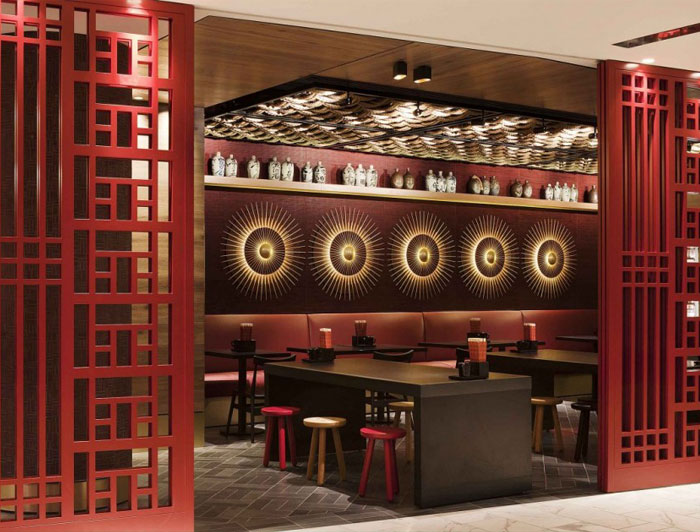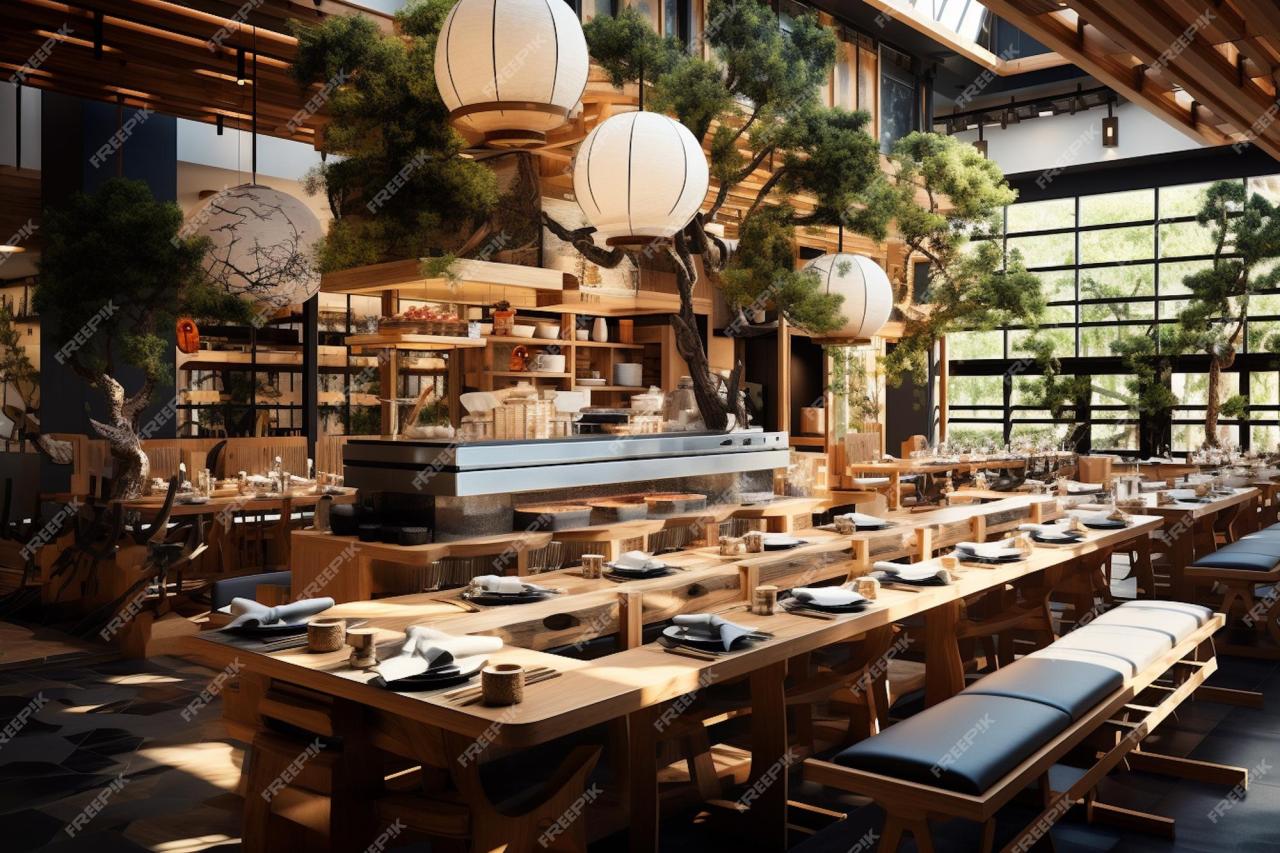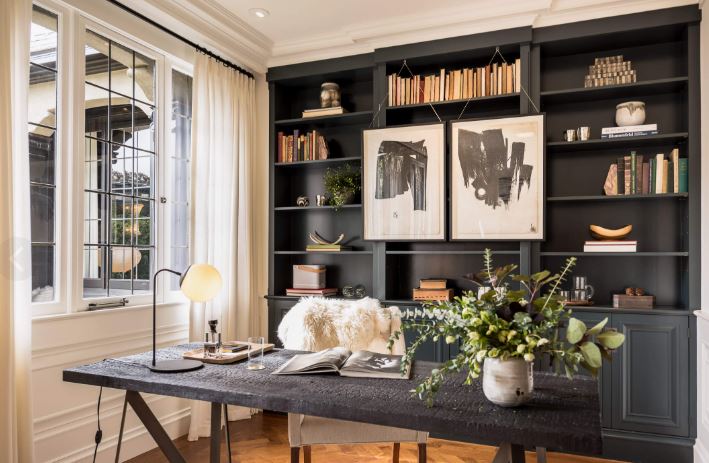Japanese modern dining space blends traditional Japanese aesthetics with contemporary design principles. This approach creates a unique and inviting atmosphere for dining, combining the beauty of natural materials like wood and bamboo with clean lines and modern functionality. The spaces are designed to be both visually appealing and highly practical, perfect for creating a memorable dining experience.
The Artikel covers everything from defining the style and its core principles to exploring different spatial arrangements, furniture choices, lighting techniques, and sustainable materials. It delves into the cultural influences that shape the design philosophy, showcasing how these spaces are not just about aesthetics but also about fostering a sense of comfort and togetherness.
Defining Japanese Modern Dining Spaces
Japanese modern dining spaces blend traditional Japanese aesthetics with contemporary design sensibilities. This results in a unique atmosphere that often emphasizes clean lines, natural materials, and a focus on creating a calm and inviting environment for dining. They stand apart from other styles by incorporating subtle, culturally relevant elements.
Japanese modern dining spaces are distinct from purely contemporary or traditional Japanese styles. They feature a careful integration of modern design principles with deeply rooted Japanese cultural values, emphasizing the seamless flow between indoor and outdoor spaces. This is achieved through a thoughtful consideration of natural light, spatial arrangement, and the choice of materials.
Aesthetic Principles and Design Elements
Japanese modern dining spaces are characterized by a harmonious balance of form and function. The design often prioritizes open floor plans, creating a sense of spaciousness and connection with the surrounding environment. Clean lines and minimalist furniture are common, allowing the natural beauty of the space to shine through. The emphasis is on creating a tranquil and inviting atmosphere that encourages conversation and relaxation. The use of natural materials like wood and bamboo creates a warm and comforting feel. The choice of materials is not merely aesthetic; it’s also a reflection of respect for nature and the environment.
Cultural Influences
The design philosophy of Japanese modern dining spaces is deeply rooted in Japanese culture. A strong appreciation for natural beauty and simplicity is evident in the use of natural light and materials. The concept of “侘び寂び (wabi-sabi)” – the beauty of imperfection and impermanence – is often incorporated. This aesthetic is reflected in the use of natural, unpolished materials and the acceptance of subtle asymmetry. Respect for tradition is another key influence, evidenced in the careful selection of materials and the subtle nods to traditional Japanese craftsmanship. For example, a meticulously crafted wooden table might feature a subtly inlaid pattern referencing a traditional design.
Materials
The use of natural materials is a cornerstone of Japanese modern dining spaces. Wood, often in its natural state, is a prominent material, adding warmth and texture. Bamboo is another frequent choice, offering a light and airy quality. Stone, particularly in muted tones, is used to create a sense of groundedness and elegance. These materials are not just decorative; they are carefully chosen to create a sense of harmony with the surrounding environment and to embody the concept of “natural beauty.”
Color Palettes and Lighting
Color palettes in Japanese modern dining spaces tend towards neutral tones. Earthy colors like beige, gray, and muted greens are prevalent, creating a calming and serene ambiance. Natural light is maximized to enhance the natural beauty of the space. When artificial lighting is required, it’s often soft and diffused, avoiding harsh glare and creating a warm and inviting atmosphere. Soft, ambient lighting, often integrated into the design, is preferred to spotlighting or overly bright fixtures. The lighting scheme is meticulously considered to complement the natural light and color palettes. For example, strategically placed recessed lighting can highlight architectural features while minimizing visual clutter.
Spatial Arrangements and Functionality
Japanese modern dining spaces prioritize a harmonious blend of functionality and aesthetic appeal. These spaces are carefully designed to facilitate social interaction and create a welcoming atmosphere, reflecting the emphasis on communal dining in Japanese culture. The spatial arrangements often incorporate elements of minimalism and natural materials, further enhancing the overall ambiance.
Open-concept designs are frequently chosen to maximize the feeling of spaciousness and to encourage interaction between family members or guests. Separated dining areas, conversely, provide a sense of privacy and intimacy, allowing for more focused conversations or activities. Multi-functional spaces, which integrate the dining area with other areas like a living room or a kitchen, are becoming increasingly popular. These arrangements adapt to different lifestyles and usage patterns, accommodating varying degrees of interaction and privacy.
Spatial Configurations
Different spatial configurations cater to diverse needs and preferences. Open-concept designs foster a sense of unity and connection, making them ideal for families and groups who enjoy socializing while dining. Separated dining areas offer a sense of seclusion, suitable for intimate gatherings or when privacy is desired. Multi-functional spaces, which blend dining, living, and kitchen areas, provide flexibility and adaptability.
Layout Options
The table below illustrates potential layout options for Japanese modern dining spaces, highlighting the allocation of roles for each area.
| Layout Type | Dining Area | Social Area | Kitchen/Prep Area |
|---|---|---|---|
| Open-Concept | A central island or a long, low table, often integrated with the living space. This allows for easy interaction between diners and those in the social area. | A living room with comfortable seating arrangements, perhaps a low coffee table, or a separate lounge area. This is designed for relaxed conversation and social gatherings. | A semi-open kitchen or a well-defined prep area with a counter for food preparation and serving, allowing for seamless transitions between cooking and dining. |
| Separated | A dedicated, enclosed dining room with a table that suits the size of the space and the intended number of diners. This fosters a sense of privacy and intimacy. | A separate living room or a dedicated social space with comfortable seating, perhaps a fireplace or a dedicated reading nook. | A separate kitchen with a prep area that might be visible from the dining space but still separated by a dividing wall or a counter. |
| Multi-Functional | A dining table that can be used for meals and other activities like games or work. It’s integrated with the living area. | The same space serves as both a living room and a social area, furnished with adaptable seating that can be used for different purposes. | A well-designed kitchen or a prep area that is seamlessly integrated into the overall design, possibly with a breakfast bar for casual meals. |
Functionality and Flow, Japanese modern dining space
The flow and functionality of these spaces are paramount. Open-concept layouts promote a natural flow between the dining, social, and kitchen areas. Separated layouts provide distinct zones for different activities, offering a sense of compartmentalization. Multi-functional spaces allow for flexible adaptation to various activities, whether it’s a formal dinner or a casual get-together. The arrangement should facilitate smooth transitions and interactions between the different zones. This ensures efficiency and comfort for the users.
Comfort and Togetherness
Spatial design plays a crucial role in promoting a sense of comfort and togetherness. Warm lighting, natural materials like wood and bamboo, and thoughtful seating arrangements contribute to a welcoming atmosphere. The design should encourage interaction between people, fostering a sense of community and connection. The layout should be ergonomic, considering the needs of different users, such as families with children or elderly individuals.
Furnishings and Accessories
Japanese modern dining spaces prioritize a blend of minimalist aesthetics and a connection to nature. This is reflected in the carefully chosen furnishings and accessories, which contribute to the overall ambiance and functionality. The emphasis is on clean lines, natural materials, and thoughtful details that create a serene and inviting atmosphere.
The selection of furniture, tableware, and artwork plays a vital role in defining the space’s character. Choosing the right pieces creates a harmonious and visually appealing environment, promoting comfort and enjoyment during meals. Natural elements, like wood and bamboo, are frequently incorporated to enhance the space’s connection to the surrounding environment.
Furniture Selection
The furniture in a Japanese modern dining space is often characterized by its simplicity and functionality. Tables and chairs should be designed with a focus on clean lines and a low profile. This approach avoids visual clutter and creates a sense of spaciousness.
- Tables: Rectangular or square tables made of solid wood like oak or maple are common choices. Alternatively, sleek, glass-topped tables with minimalist wooden bases provide a modern touch. The table’s size should be proportionate to the dining space and the number of guests expected.
- Chairs: Comfortable, yet simple chairs with low backs and slender legs are preferred. Materials like light-colored wood, bamboo, or upholstered seats in neutral tones create a calming atmosphere. Consider using chairs with a slightly curved backrest to offer a subtle touch of elegance.
- Seating Arrangements: A flexible seating arrangement allows for both intimate gatherings and larger gatherings. Low, square ottomans or benches can serve as additional seating options, providing a versatile and welcoming space.
Seating Styles and Materials
Different seating styles offer varied levels of comfort and visual appeal. The selection depends on the desired atmosphere and the personal preferences of the space’s occupants.
- Traditional Japanese Seating (Shoji): Low stools or cushions (zabuton) on the floor are perfect for creating a sense of intimacy and connection with the surrounding environment. This style adds a touch of cultural authenticity to the space.
- Western-Style Chairs: Classic chairs with upholstered seats offer a more familiar and comfortable seating experience. Choose chairs with clean lines and neutral colors to maintain the minimalist aesthetic.
- Materials: Natural materials like wood, bamboo, and rattan are frequently used. The warm tones and textures of these materials create a connection to nature. Metal elements, such as stainless steel or brushed aluminum, can add a modern touch to the space. Leather or fabric upholstery can provide a touch of softness and comfort while maintaining the clean lines.
Accessories and Their Role
The use of accessories is crucial in enhancing the overall aesthetic and ambiance of a Japanese modern dining space. Carefully selected tableware, textiles, and artwork can elevate the space’s visual appeal and create a unique atmosphere.
- Tableware: Elegant, simple tableware in neutral colors like white, gray, or black is ideal. Consider using ceramics or porcelain with a matte finish to enhance the minimalist aesthetic. Avoid overly ornate or patterned designs. Using wooden chopsticks or serving utensils adds a subtle touch of warmth.
- Textiles: Natural fabrics like linen or cotton can be used for tablecloths or napkins. These materials add texture and warmth to the space while complementing the minimalist furniture. Use subtle patterns or solid colors to maintain the overall aesthetic.
- Artwork: Minimalist or abstract artwork can be incorporated to add visual interest without overwhelming the space. Prints or framed calligraphy pieces that incorporate natural elements can complement the theme.
Incorporating Natural Elements
Integrating natural elements into the furnishings selection adds depth and serenity to the space. The use of natural materials, colors, and textures creates a connection to the surrounding environment.
- Materials: Use natural materials like wood, bamboo, rattan, or stone for tables, chairs, and accessories. These materials offer a warm and inviting touch to the space.
- Colors: Incorporate earthy tones like beige, brown, and gray to evoke a sense of calm and connection to nature. Use greenery or plants to further enhance the natural theme.
- Textures: Introduce various textures like the smooth surface of wood, the natural grain of bamboo, or the softness of linen to create visual and tactile interest.
Furniture Style Comparison
| Furniture Style | Description | Suitability | Visual Appeal |
|---|---|---|---|
| Minimalist | Clean lines, simple forms, neutral colors, emphasis on functionality. | Excellent; aligns perfectly with the Japanese modern aesthetic. | Modern, sophisticated, spacious, and calming. |
| Scandinavian | Warm and inviting, natural materials, light colors, focus on comfort. | Good; complements the Japanese modern aesthetic by emphasizing natural elements. | Cozy, inviting, and visually appealing. |
| Industrial | Raw materials, exposed elements, metal accents, bold lines. | Less suitable; may clash with the minimalist and natural theme. | Modern, bold, and unique, but potentially disruptive to the desired aesthetic. |
Lighting and Atmosphere

Source: interiorzine.com
Japanese modern dining spaces often feature clean lines and minimalist design, creating a calming atmosphere. This aesthetic often aligns with a timeless dining room style, like the ones found in Timeless dining room style , which emphasizes enduring elegance and sophisticated simplicity. Ultimately, these spaces aim for a sense of calm and sophistication, making them perfect for both casual gatherings and formal dinners.
Lighting plays a crucial role in setting the mood and ambiance of a Japanese modern dining space. It’s not just about illumination; it’s about creating a sense of warmth, intimacy, and visual interest that complements the clean lines and minimalist aesthetic. Proper lighting can subtly guide the eye through the space, highlighting key architectural features and enhancing the overall dining experience.
The carefully considered use of lighting can significantly impact the perception of the space. It can make a room feel larger or cozier, more formal or relaxed, depending on the specific lighting choices. The right balance between different light types is essential to achieve the desired effect.
Ambient Lighting
Ambient lighting provides the foundational illumination for the space. It ensures the entire dining area is sufficiently lit without harsh glare or shadows. This often involves strategically placed recessed lighting or cove lighting that gently bathes the room in soft light. For example, warm-toned LED recessed lighting can create a welcoming and cozy atmosphere. Alternatively, strategically placed, low-hanging pendant lights or chandeliers with diffused light can achieve a similar effect, adding visual interest and a touch of elegance. In some cases, a combination of lighting sources can work best to achieve the desired effect.
Task Lighting
Task lighting is essential for specific activities like reading menus or preparing food. Well-placed task lighting is particularly important in Japanese modern dining spaces to maintain a balance between functionality and aesthetic appeal. It can take the form of adjustable pendant lights over specific tables, or wall-mounted sconces with focused beams that can be aimed directly at work areas. In modern dining areas, a combination of ambient and task lighting can ensure that each area is well-lit while maintaining a visually pleasing ambiance. For example, a small, sleek table lamp on a side table provides focused illumination for reading menus without overwhelming the dining space.
Accent Lighting
Accent lighting is used to highlight architectural features or specific design elements, like artwork or decorative objects. By strategically placing spotlights or directional fixtures, it draws attention to focal points, adding depth and visual interest to the space. This approach allows for showcasing specific aspects of the room’s design while maintaining a unified and cohesive aesthetic. For instance, a spotlight aimed at a beautifully crafted wall or ceiling feature can add a touch of drama to the dining space. Similarly, a well-placed picture light can emphasize the visual interest of artwork. The use of color-changing LED strips can also add a touch of dynamism to the space, creating an atmosphere that is both inviting and contemporary.
Highlighting Architectural Features
Well-placed lighting fixtures can significantly enhance the architectural design of a Japanese modern dining space. Consider using lighting to draw attention to features like unique ceilings, wood beams, or custom cabinetry. By using targeted spotlights, the unique character of these features can be accentuated without overwhelming the space. For instance, if the room has a stunning ceiling design, highlighting it with strategically placed spotlights can create a focal point that enhances the dining experience.
Visual Representation and Inspiration

Source: freepik.com
Japanese modern dining spaces often feature minimalist designs, focusing on clean lines and natural materials. They frequently incorporate elements of high-end dining room decor, like exquisite tableware and sophisticated lighting, to create a refined yet welcoming atmosphere. This attention to detail elevates the dining experience, making these spaces truly special. For more inspiration on high-end dining room decor, check out this resource: High-end dining room decor.
Ultimately, these spaces are a testament to the beauty of Japanese design principles.
A visually appealing Japanese modern dining space transcends mere functionality; it cultivates an atmosphere of tranquility and sophistication. The design elements, from the chosen color palette to the carefully selected materials, work in harmony to create a unique and inviting experience. This is achieved through a thoughtful consideration of natural light, textures, and the overall ambiance.
The interplay of light and shadow, the subtle nuances of color, and the warmth of natural materials all contribute to the overall experience. Inspiration comes from a variety of sources, including traditional Japanese aesthetics and contemporary design principles, which when integrated seamlessly, result in a space that is both elegant and inviting.
Color Palette and Texture
The color palette in a Japanese modern dining space often evokes a sense of serenity. Subtle shades of grey, beige, and muted greens are frequently employed, creating a calming backdrop. These colors are often complemented by pops of deeper tones, like charcoal grey or navy blue, which add a touch of sophistication without overwhelming the space. The interplay of light and shadow further enhances the visual interest, creating a dynamic and engaging atmosphere. The textures employed should be just as carefully considered, ranging from the smooth surfaces of polished wood to the natural grain of bamboo. These textures provide visual interest and add a sense of depth and warmth to the space.
Material Selection
Natural materials are paramount in Japanese modern design, often featuring prominently in both furniture and accessories. Wood, bamboo, and stone are frequently used, with each material chosen for its inherent beauty and functionality. The warmth and natural character of these materials create a sense of connection with nature, which is a key element in Japanese design philosophy. The choice of materials extends to textiles, often incorporating natural fibers like linen or cotton, adding an element of softness and comfort to the space. For example, a dining table made of reclaimed wood, paired with bamboo chairs and a natural linen tablecloth, embodies the essence of this approach. A stone-clad wall provides a cool contrast to the warmth of the wood.
Natural Light and its Impact
Natural light plays a crucial role in shaping the ambiance of a Japanese modern dining space. Large windows, strategically positioned to maximize natural light, flood the room with warmth and create a sense of spaciousness. The diffused light filters through sheer curtains or paper screens, creating a soft, gentle glow that enhances the overall aesthetic. The careful placement of furniture around the windows allows for a direct interaction with the natural environment, bringing the outdoors in. The changing quality of natural light throughout the day, from the soft morning light to the warm evening glow, further enriches the dining experience.
Visual Inspiration from Existing Spaces
One example of a Japanese modern dining space might feature a minimalist wooden dining table with low, sleek benches crafted from oiled bamboo. The walls are a soft neutral color, allowing the natural light to bathe the space in a warm glow. Large sliding doors open to a serene garden, blurring the lines between indoors and outdoors. The subtle use of paper lanterns and minimalist décor further emphasizes the tranquil atmosphere. Another example might use a large, open-plan space, with a central, light-filled dining area. The dining table, made of polished concrete, contrasts beautifully with the natural wood of the surrounding cabinetry and the soft, natural textures of the cushions on the benches. The space incorporates a Zen-like quality through its meticulous attention to detail and the use of natural elements.
Creating a Positive Dining Experience
The overall design and ambiance contribute significantly to a positive dining experience in a Japanese modern dining space. The harmony of colors, textures, and materials, coupled with the abundant natural light, creates a soothing and inviting environment. The emphasis on natural elements promotes a sense of calm and tranquility, which is conducive to relaxed conversation and enjoyable meals. The minimalist aesthetic encourages a focus on the food and the company, rather than the surrounding décor. Ultimately, the design aims to create a space that transcends functionality and elevates the dining experience to an art form.
Materials and Sustainability
Japanese modern dining spaces often prioritize a harmonious blend of aesthetics and environmental responsibility. Choosing sustainable materials is integral to this philosophy, reflecting a commitment to minimizing the impact on the planet while maintaining the beauty and functionality of the space. This approach not only reduces the carbon footprint but also contributes to a more durable and long-lasting design.
Sustainability isn’t just about using recycled materials; it encompasses the entire lifecycle of the product, from sourcing and production to disposal. A mindful approach to material selection and construction ensures a positive impact throughout the design process.
Sustainable Materials Frequently Used
Japanese modern design often incorporates a range of sustainable materials. Natural wood, sourced responsibly from well-managed forests, is a cornerstone. Recycled materials, like reclaimed wood or repurposed metal, offer an interesting aesthetic and a strong message of environmental awareness. Bamboo, known for its rapid growth and strength, is another excellent option. These materials are not only visually appealing but also contribute to a space’s eco-friendly credentials.
Importance of Environmentally Friendly Choices
Integrating environmentally friendly choices is crucial for the long-term health of the planet and the well-being of future generations. By selecting sustainable materials, designers and clients minimize the negative impact of construction on the environment, thereby promoting responsible consumption. This commitment reduces reliance on unsustainable resources and promotes the use of renewable alternatives, reflecting a proactive approach to environmental stewardship.
Incorporating Eco-Conscious Materials and Practices
The incorporation of eco-conscious materials and practices can be seamlessly integrated into the design process. For instance, using locally sourced materials reduces transportation emissions and supports local economies. Employing energy-efficient lighting fixtures, such as LED bulbs, significantly decreases the space’s energy consumption. Careful waste management and recycling protocols minimize landfill waste, completing the cycle of sustainable design.
Examples of Innovative Sustainable Materials
Innovative sustainable materials are constantly emerging. Recycled plastic lumber, for example, offers a durable and aesthetically pleasing alternative to traditional wood, significantly reducing the reliance on virgin resources. Bio-based composite materials, made from plant-derived sources, provide an eco-friendly alternative to many synthetic materials, often with comparable performance characteristics. The application of these materials in flooring, cabinetry, and other furniture components can create stunning and sustainable designs.
Methods to Demonstrate Sustainability
Demonstrating the importance of sustainability in the design process involves several approaches. Clear labeling and documentation of the materials used, including certifications and sourcing information, provide transparency and credibility. Creating visual displays or educational materials that highlight the environmental benefits of the chosen materials educates clients and reinforces the commitment to sustainability. Including a dedicated sustainability section in the design proposal, outlining the materials’ environmental impact and the methods used to minimize it, further solidifies the project’s eco-friendly credentials.
Last Recap
In conclusion, Japanese modern dining spaces offer a captivating blend of tradition and innovation. By carefully considering the interplay of materials, spatial arrangements, and lighting, designers can create spaces that are not only beautiful but also highly functional and sustainable. This approach fosters a positive and memorable dining experience for everyone.
FAQ Explained: Japanese Modern Dining Space
What are some common materials used in Japanese modern dining spaces beyond wood and bamboo?
Stone, concrete, and even metal accents are frequently used to create a contrast and add a modern touch to the natural elements. Think polished concrete floors or sleek metal accents on furniture.
How can I create a sense of openness in a Japanese modern dining space, even if it’s smaller?
Open-concept layouts are often ideal, but even a smaller space can feel airy with the right design choices. Mirrors, strategic lighting, and light-colored walls can help expand the perceived area.
What are some sustainable alternatives to traditional wood in Japanese modern furniture?
Reclaimed wood, bamboo, and even engineered wood products can be excellent sustainable alternatives. Look for furniture made with responsibly sourced materials.
What types of lighting fixtures are best for a Japanese modern dining space?
Simple, minimalist fixtures that complement the overall aesthetic work well. Think pendant lights with clean lines, or recessed lighting that doesn’t overpower the space.
Japanese modern dining spaces often feature clean lines and minimalist design, creating a serene atmosphere. Think about how these spaces can be adapted for a more vibrant aesthetic, drawing inspiration from Stylish dining room interiors to add pops of color or interesting textures. Ultimately, a Japanese modern dining space aims for a balance of visual appeal and functionality.
Japanese modern dining spaces often feature minimalist designs, focusing on clean lines and natural materials. Think about how a modern elegant dining room, like the ones you can see in Modern elegant dining room , can inspire similar aesthetic choices. Ultimately, the goal in a Japanese modern dining space is to create a serene and functional environment for enjoying meals.
- Pivot Glass Doors A Stylish Choice - June 2, 2025
- Mountain Modern Cabin A Stylish Retreat - May 6, 2025
- Modern Loft House A Stylish Home - May 6, 2025









